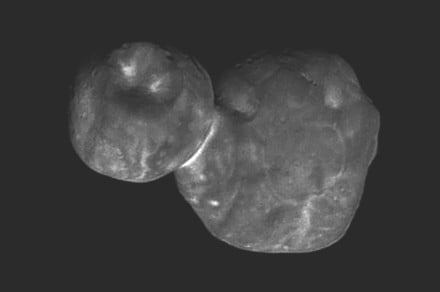Ultima Thule, the farthest object ever explored, has yet more mysteries to reveal. Forget the debates about whether it is looks most like a snowman or more like Star Wars‘ BB-8 — NASA scientists have revealed that it is even more oddly shaped than previously thought.
A sequence of 14 images taken by New Horizons has been processed and strung together to show the shape and movement of this strange object. The central frame of the image was captured on January 1, 2019 during the New Year’s Day flyby:
[youtube https://www.youtube.com/watch?v=6i6K6kUOgxY?feature=oembed&w=100&h=100]
It’s hard to see in the video, but scientists have been able to work out more about the object’s shape by looking at the way that it blocks out the stars behind it as it passes by. The researchers have found that the object does indeed have two lobes as thought, but neither lobe is spherical. The larger lobe, called Ultima, is more of a “pancake” shape, while the smaller lobe, Thule, is more like a “dented walnut.” However, there is still some degree of uncertainty over what the exact shape of the object is because parts of it were hidden from view and were not illuminated by the light from the Sun.
In the image below, you can see a comparison of the previous model of the object and the new updated model, with blue dashed lines representing areas of uncertainty where the object could be flatter than or more curved than the current image shows:
Scientists’ understanding of Ultima Thule has changed as they review additional data. The “old view” in this illustration is based on images taken within a day of New Horizons’ closest approach to the Kuiper Belt object on Jan. 1, 2019. The bottom view is the team’s current best shape model for Ultima Thule, but still carries some uncertainty as an entire region was essentially hidden from view, and not illuminated by the Sun, during the New Horizons flyby. NASA/Johns Hopkins University Applied Physics Laboratory/Southwest Research Institute
The new data raises new questions, however, such as how the object developed this peculiar shape. “We had an impression of Ultima Thule based on the limited number of images returned in the days around the flyby, but seeing more data has significantly changed our view,” Principal Investigator Alan Stern, of Southwest Research Institute, said in a statement. “It would be closer to reality to say Ultima Thule’s shape is flatter, like a pancake. But more importantly, the new images are creating scientific puzzles about how such an object could even be formed. We’ve never seen something like this orbiting the Sun.”
Editors’ Recommendations
- NASA probe visits Ultima Thule, the farthest object humanity has ever reached
- Get your Sagan on with 60 awe-inspiring photos of the final frontier
- Blizzard’s latest hiring spree is likely for the unannounced ‘Diablo 4’
- 2019 Toyota RAV4 first drive review
- This is the coolest gaming tech at CES 2019, from laptops to the Teslasuit

